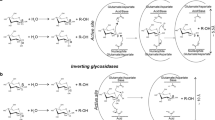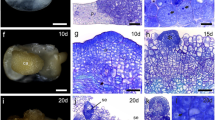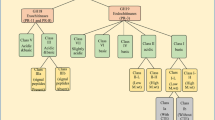Abstract
Key message
A novel Brassica oleracea lectin with two tandem MATH domains in its structure has been characterized. The expression of the lectin is regulated by light and by stimuli related to plant defence response. The coding sequence of the protein has been cloned and a fully functional recombinant protein has been obtained.
Abstract
BOL (Brassica oleracea Lectin) is a novel lectin isolated from Brassica oleracea ssp. Botrytis, composed of a single subunit, non-glycosylated peptide that contains two conserved MATH domains, not previously found in any other characterized lectin. The complete sequence encoding BOL was obtained by PCR using degenerated primers designed according to the N-terminal amino acid sequence and the sequences of various tryptic peptides obtained by the digestion of the purified native protein. The entire cDNA consists of 1053 bp, which encodes a 301-amino acid protein. In silico analysis of the Bol promoter sequence showed several regulatory motifs that could be involved in responses to various stresses, as well as various light regulatory elements. Determination of Bol expression in plant tissues showed higher transcript levels in the leaves than in the stems and the roots. The expression of Bol was regulated by light and by signalling compounds related to stress responses. Specifically, Bol expression was higher in light than in darkness, and was induced by methyl jasmonate, while it decreased in tissues treated with salicylic acid. The full-length BOL coding sequence was cloned, expressed in bacteria, and activity assays were performed to ascertain that the recombinant protein was correctly folded and was able to recognize and bind carbohydrates as the native lectin did. Three-dimensional structure prediction showed that this lectin had a dome-like structure with a closely related topology to l-lectins but with two characteristic MATH domains. Isolation, cloning and recombinant expression of BOL may be helpful to understand its physiological function in the plant and opens the possibility of subsequent investigations about the structural features of this novel lectin.







Similar content being viewed by others
References
Dang L, Rouge P, Van Damme EJM (2017) Amaranthin-like proteins with aerolysin domains in plants. Front Plant Sci 8:1368. https://doi.org/10.3389/fpls.2017.01368
De Hoff P, Brill L, Hirsch A (2009) Plant lectins: the ties that bind in root symbiosis and plant defense. Mol Genet Genomics 282:1–15. https://doi.org/10.1007/s00438-009-0460-8
De Schutter K, Van Damme E (2015) Protein-carbohydrate interactions as part of plant defense and animal immunity. Molecules 20:9029–9053. https://doi.org/10.3390/molecules20059029
Delaney TP, Uknes S, Vernooij B et al (1994) A central role of salicylic acid in plant disease resistance. Science 266:1247–1250. https://doi.org/10.1126/science.266.5188.1247
Diaz-De-Leon F, Klotz KL, Lagrimini LM (1993) Nucleotide sequence of the tobacco (Nicotiana tabacum) anionic peroxidase gene. Plant Physiol 101:1117–1118. https://doi.org/10.1104/pp.101.3.1117
Duarte CEM, Abranches MV, Silva PF et al (2017) A new TRAF-like protein from Brassicaoleracea ssp. botrytis with lectinic activity and its effect on macrophages. Int J Biol Macromol 1:508–514. https://doi.org/10.1017/CBO9781107415324.004
Dumon-Seignovert L, Cariot G, Vuillard L (2004) The toxicity of recombinant proteins in Escherichiacoli: a comparison of over expression in BL21(DE3), C41(DE3), and C43(DE3). Protein Expr Purif 37:203–206. https://doi.org/10.1016/j.pep.2004.04.025
Etzler ME, Surolia A, Cummings RD (2009) L-type lectins. In: Varki A, Cummings RD, Esko JD et al (eds) Essentials of glycobiology, 2nd edn. Cold Spring Harbor, NY, pp 415–424. https://www.ncbi.nlm.nih.gov/books/NBK1935
Fujimoto Z, Tateno H, Hirabayashi J (2014) Lectin structures: classification based on the 3-D structures. Methods Mol Biol 1200:579–606. https://doi.org/10.1007/978-1-4939-1292-6_46
Fujita M, Fujita Y, Noutoshi Y et al (2006) Crosstalk between abiotic and biotic stress responses: a current view from the points of convergence in the stress signaling networks. Curr Opin Plant Biol 9:436–442. https://doi.org/10.1016/j.pbi.2006.05.014
Gasteiger E, Hoogland C, Gattiker A et al (2005) Protein identification and analysis tools on the ExPASy server. Proteomics Protoc Handb. https://doi.org/10.1385/1-59259-890-0:571
Gemeiner P, Mislovičová D, Tkáč J et al (2009) Lectinomics II. A highway to biomedical/clinical diagnostics. Biotechnol Adv 27:1–15. https://doi.org/10.1016/j.biotechadv.2008.07.003
Goodstein DM, Shu S, Howson R et al (2012) Phytozome: a comparative plataform for green plant genomics. Nucleic Acids Res 40:D1178–1186. https://doi.org/10.1093/nar/gkr944
Howard IK, Sage HJ, Horton CB (1972) Studies on the appearance and location of hemagglutinins from a common lentil during the life cycle of the plant. Arch Biochem Biophys 149:323–326. https://doi.org/10.1016/0003-9861(72)90328-1
Hu M, Gu L, Li M et al (2006) Structural basis of competitive recognition of p53 and MDM2 by HAUSP/USP7: implications for the regulation of the p53-MDM2 pathway. PLOS Biol 4:228–239. https://doi.org/10.1371/journal.pbio.0040027
Källberg M, Wang H, Wang S et al (2012) Template-based protein structure modeling using the RaptorX web server. Nat Protoc 7:1511–1522. https://doi.org/10.1038/nprot.2012.085
Kazan K, Lyons R (2014) Intervention of phytohormone pathways by pathogen effectors. Plant Cell 26:2285–2309. https://doi.org/10.1105/tpc.114.125419
Kendrick RE, Kerckhoffs LHJ, Van Tuinen A, Koornneef M (1997) Photomorphogenic mutants of tomato. Plant Cell Environ 20:746–751. https://doi.org/10.1046/j.1365-3040.1997.d01-109.x
Koornneef A, Pieterse CMJ (2008) Cross talk in defense signaling. Plant Physiol 146:839–844. https://doi.org/10.1104/pp.107.112029
Kusnetsov V, Landsberger M, Meurer J, Oelmüller R (1999) The assembly of the CAAT-box binding complex at a photosynthesis gene promoter is regulated by light, cytokinin, and the stage of the plastids. J Biol Chem 274:36009–36014. https://doi.org/10.1074/jbc.274.50.36009
Lannoo N, Van Damme EJM (2010) Nucleocytoplasmic plant lectins. Biochim Biophys Acta 1800:190–201. https://doi.org/10.1016/j.bbagen.2009.07.021
Lannoo N, Van Damme EJM (2014) Lectin domains at the frontiers of plant defense. Front Plant Sci 5:397. https://doi.org/10.3389/fpls.2014.00397
Lescot M (2002) PlantCARE, a database of plant cis-acting regulatory elements and a portal to tools for in silico analysis of promoter sequences. Nucleic Acids Res 30:325–327. https://doi.org/10.1093/nar/30.1.325
Livak KJ, Schmittgen TD (2001) Analysis of relative gene expression data using real-time quantitative PCR and the 2(−∆∆ C(T)) method. Methods 25:402–408. https://doi.org/10.1006/meth.2001.1262
Macedo M, Oliveira C, Oliveira C (2015) Insecticidal activity of plant lectins and potential application in crop protection. Molecules 20:2014–2033. https://doi.org/10.3390/molecules20022014
McWilliam H, Li W, Uludag M et al (2013) Analysis tool web services from the EMBL-EBI. Nucleic Acids Res 41:W597–600. https://doi.org/10.1093/nar/gkt376
Mundy J, Chua NH (1988) Abscisic acid and water-stress induce the expression of a novel rice gene. EMBO J 7:2279–2286. https://doi.org/10.1002/j.1460-2075.1988.tb03070.x
Oelmüller R, Peškan-Berghöfer T, Shahollari B et al (2005) MATH domain proteins represent a novel protein family in Arabidopsisthaliana, and at least one member is modified in roots during the course of a plant-microbe interaction. Physiol Plant 124:152–166. https://doi.org/10.1111/j.1399-3054.2005.00505.x
Peumans WJ, Van Damme EJ (1995) Lectins as plant defense proteins. Plant Physiol 109:347–352. https://doi.org/10.1104/pp.109.2.347
Qi H, Xia FN, Xie LJ et al (2017) TRAF-family proteins regulate autophagy dynamics by modulating AUTOPHAGY PROTEIN6 stability in Arabidopsis. Plant Cell 29:890–911. https://doi.org/10.1105/tpc.17.00056
Robichon C, Luo J, Causey TB et al (2011) Engineering Escherichiacoli BL21(DE3) derivative strains to minimize E.coli protein contamination after purification by immobilized metal affinity chromatography. Appl Environ Microbiol 77:4634–4646. https://doi.org/10.1128/AEM.00119-11
Rosano GL, Ceccarelli EA (2014) Recombinant protein expression in Escherichiacoli: advances and challenges. Front Microbiol 5:1–17. https://doi.org/10.3389/fmicb.2014.00172
Saeed B, Baranwal VK, Khurana P (2016) Identification and expression profiling of the lectin gene superfamily in mulberry. Plant Genome. https://doi.org/10.3835/plantgenome2015.10.0107
Sharon N, Lis H (1987) A century of lectin research (1888–1988). Trends Biochem Sci 12:488–491. https://doi.org/10.1016/0968-0004(87)90236-2
Sharon N, Lis H (1990) Legume lectins—a large family of homologous proteins. FASEB J 4:3198–3208. https://doi.org/10.1096/fasebj.4.14.2227211
Sharon N, Lis H (2002) How proteins bind carbohydrates: lessons from legume lectins. J Agric Food Chem 50:6586–6591. https://doi.org/10.1021/jf020190s
Sharon N, Lis H (2004) History of lectins: from hemagglutinins to biological recognition molecules. Glycobiology 14:53R–62R. https://doi.org/10.1093/glycob/cwh122
Sibéril Y, Doireau P, Gantet P (2001) Plant bZIP G-box binding factors. Modular structure and activation mechanisms. Eur J Biochem 268:5655–5666. https://doi.org/10.1046/j.0014-2956.2001.02552.x
Scholz SS, Schmidt-Heck W et al (2018) Verticillium dahliae-Arabidopsis interaction causes changes in gene expression profiles and jasmonate levels on different time scales. Front Microbiol 9:217. https://doi.org/10.3389/fmicb.2018.00217
Tanaka S, Mochizuki N, Nagatani A (2002) Expression of the AtGH3a gene, an Arabidopsis homologue of the soybean GH3 gene, is regulated by phytochrome B. Plant Cell Physiol 43:281–289. https://doi.org/10.1093/pcp/pcf033
Urao T, Yamaguchi-Shinozaki K, Urao S, Shinozaki K (1993) An Arabidopsis myb homolog is induced by dehydration stress and its gene product binds to the conserved MYB recognition sequence. Plant Cell 5:1529–1539. https://doi.org/10.1105/tpc.5.11.1529
Van Damme EJM, Barre A, Rougé P, Peumans WJ (2004) Cytoplasmic/nuclear plant lectins: a new story. Trends Plant Sci 9:484–489. https://doi.org/10.1016/j.tplants.2004.08.003
Van Damme EJM, Lannoo N, Peumans WJ (2008) Plant lectins. In: Advances in botanical research, vol 48. Elsevier Ltd, pp 107–209. https://doi.org/10.1016/S0065-2296(08)00403-5
Vasina JA, Baneyx F (1997) Expression of aggregation-prone recombinant proteins at low temperatures: a comparative study of the Escherichiacoli cspA and tac promoter systems. Protein Expr Purif 9:211–218. https://doi.org/10.1006/prep.1996.0678
Wagner S, Klepsch MM, Schlegel S et al (2008) Tuning Escherichiacoli for membrane protein overexpression. Proc Natl Acad Sci USA 105:14371–14376. https://doi.org/10.1073/pnas.0804090105
Weber E, Neumann D (1980) Protein bodies, storage organelles in plant seeds. Biochem und Physiol der Pflanzen 175:279–306. https://doi.org/10.1016/S0015-3796(80)80070-9
White AJ, Alison Dunn M, Brown K, Hughes MA (1994) Comparative analysis of genomic sequence and expression of a lipid transfer protein gene family in winter barley. J Exp Bot 45:1885–1892. https://doi.org/10.1093/jxb/45.12.1885
Xie P (2013) TRAF molecules in cell signaling and in human diseases. J Mol Signal 8:7. https://doi.org/10.1186/1750-2187-8-7
Xu Y, Chang P, Liu D et al (1994) Plant defense genes are synergistically induced by ethylene and methyl jasmonate. Plant Cell 6:1077–1085. https://doi.org/10.1105/tpc.6.8.1077
Zapata JM, Martínez-garcía V, Lefebvre S (2007) Phylogeny of the TRAF/MATH domain. Adv Bot Res Exp Med Biol. https://doi.org/10.1007/978-0-387-70630-6_1
Acknowledgements
This work was supported by Conselho Nacional de Desenvolvimento Científico e Tecnológico (CNPq 474715/2013-2), by Fundação de Amparo à Pesquisa do Estado de Minas Gerais (FAPEMIG APQ-01463-17) and by Ministerio de Economia y Competitividad, Spain (AGL2015-69554-P); CEM Duarte was recipient of a PhD fellowship from Coordenação de Aperfeiçoamento de Pessoal de Nível Superior, and an ERASMUS+ CeiA3 exchange Grant from the European Union program.
Author information
Authors and Affiliations
Corresponding author
Ethics declarations
Conflict of interest
The authors declare that they have no conflict of interest.
Additional information
Communicated by Z.-L. Zhang.
Publisher's Note
Springer Nature remains neutral with regard to jurisdictional claims in published maps and institutional affiliations.
Electronic supplementary material
Below is the link to the electronic supplementary material.
Rights and permissions
About this article
Cite this article
Duarte, C.E.M., Alamillo, J.M., Koehler, A.D. et al. Molecular and biochemical analyses of a novel lectin with MATH domains from Brassica oleracea. Acta Physiol Plant 42, 79 (2020). https://doi.org/10.1007/s11738-020-03070-8
Received:
Revised:
Accepted:
Published:
DOI: https://doi.org/10.1007/s11738-020-03070-8




